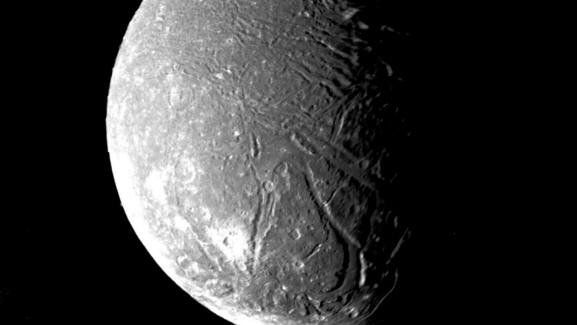Ariel is one of the moons of Uranus, it has a diameter of 579 kilometers to be exact, this moon of Uranus with a cracked and quite young surface, the surface is young because there are very few craters, under that icy and complex surface because it has activity geological, now according to some researchers they affirm that there may be a mass of liquid water, they do not dare to say that it is a global ocean because among other things the moon is small so it would rather be the mass of a sea, not an ocean, but at least one mass of liquid water can exist.
Unfortunately the only spacecraft that has visited Uranus and its entire system of moons was the Vayager 2 spacecraft in 1986 and also unfortunately it did not manage to take complete images of Ariel, because it did not actually stay orbiting Uranus, it passed by, so it took all the images. images that could and could not fully capture this Moon.
One of the characteristics that this moon has is the Kra Chasma canyon with more than 620 km in length, which extends to the Ariel hemisphere that Voyager 2 could not see illuminated, therefore perhaps it is even longer, the researchers arrived at to the conclusion that under the icy surface of Ariel there is a mass of liquid water, in a somewhat curious shape.

Souce
They have discovered with the help of James Webb and other data that this Moon is covered with a significant amount of carbon dioxide ice, especially in the trailing hemisphere, which always faces in the opposite direction to the motion of the Moon's orbit. And the fact that it has carbon dioxide is surprising and curious, because even in the coldest areas of the Uranus system, which is quite far away, CO2 is easily transformed into gas and these low-gravity objects because it is small, as you can see, cannot retain CO2 and they lose space.
These small moons cannot have an atmosphere, they do not have enough gravity to retain the gases, so something had to be supplying CO2 to the surface of Ariel because otherwise it could be there and that something according to these researchers who published their study on December 24 July in The astrophysical journal letters is that this CO2 comes from a mass of underground liquid water.
Ariel is the fourth largest satellite of Uranus, and is similar in size to Saturn's moon Enceladus, which we do know has a surface water ocean under the ice layer, so it could be a very similar case to Enceladus. another small world with liquid water and therefore with the possibility of having developed life forms.
They should release a Voyager with better equipment to send a mission to Neptune and Uranus, the problem with sending this type of mission is that solar energy does not work, the solar panels barely capture the light there, therefore, you have to carry an atomic battery, with an atomic battery a reactor, let's go and the problem with atomic batteries is that they wear out, they last at most 20 years, and of course between what the travel time costs and how much you can use the ship there can happen many years.
Study Source
The images without reference were created with AI
Thank you for visiting my blog. If you like posts about
#science,
#planet,
#politics,
#rights #crypto,
#traveling and discovering secrets and beauties of the
#universe, feel free to Follow me as these are the topics I write about the most. Have a wonderful day and stay on this great platform :) :)
! The truth will set us free and science is the one that is closest to the truth!


Thanks for your contribution to the STEMsocial community. Feel free to join us on discord to get to know the rest of us!
Please consider delegating to the @stemsocial account (85% of the curation rewards are returned).
You may also include @stemsocial as a beneficiary of the rewards of this post to get a stronger support.